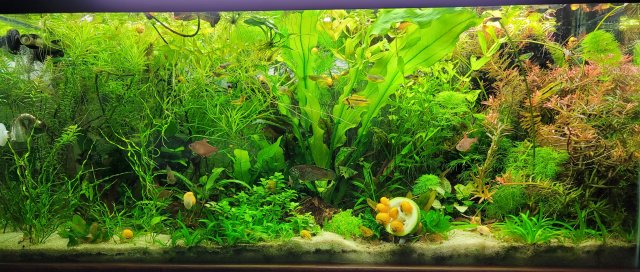This is a project that is still about 12 months out but i wanted a sanity check on planned stocking. The tank is approx 8ftx4ftx21 (l,w,h) or a bit over 400 gallons.
-
The plan right now is to use torpedo beach or crystal river - an off white substrate by caribsea.
-
The target temp is 81 during the winter and 83 during the summer (some fishes need a seasonsal temp change) and the target tds is 60 (but this might be adjusted a little).
-
tank will have a sump and will likely use a drip system at 1gph for water changes - and maybe once a month or so vaccum up plant waste - maybe twice a month depends on water condition.
-
Right now i'm aiming for low-tech tank since i worry that co2 in a warm tank might cause issues; still it will be heavily planted with quite a bit of driftwood.
-
The planned fishes are approx 20 sterbai,
25 rams (mix of gold, electric blue, german blue, ...),
6 to 8 geo - likely winemilleri,
4 or 5 pleco - mostly l204 but perhaps a pair of gold nugget.
40ish cardinal tetra
40ish antoher tetra - probably lemon or gold tetra - or runny nose.
one other dwarf cichlid - probably macmasteri (m/f/f?) or brevis but perhaps some other dwarf cichlid (suggestion? need to do a bit more research here)
-
The plan right now is to use torpedo beach or crystal river - an off white substrate by caribsea.
-
The target temp is 81 during the winter and 83 during the summer (some fishes need a seasonsal temp change) and the target tds is 60 (but this might be adjusted a little).
-
tank will have a sump and will likely use a drip system at 1gph for water changes - and maybe once a month or so vaccum up plant waste - maybe twice a month depends on water condition.
-
Right now i'm aiming for low-tech tank since i worry that co2 in a warm tank might cause issues; still it will be heavily planted with quite a bit of driftwood.
-
The planned fishes are approx 20 sterbai,
25 rams (mix of gold, electric blue, german blue, ...),
6 to 8 geo - likely winemilleri,
4 or 5 pleco - mostly l204 but perhaps a pair of gold nugget.
40ish cardinal tetra
40ish antoher tetra - probably lemon or gold tetra - or runny nose.
one other dwarf cichlid - probably macmasteri (m/f/f?) or brevis but perhaps some other dwarf cichlid (suggestion? need to do a bit more research here)



